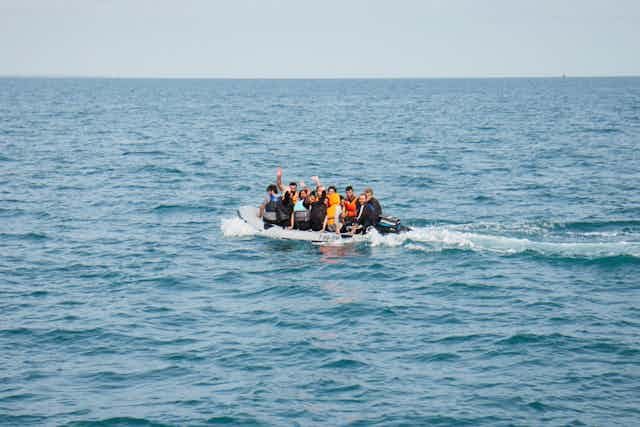Record numbers of migrants have reportedly been crossing the English Channel into Britain, with news websites full of photos of people on tiny boats making the dangerous crossing from France. According to some reports, at least 430 migrants reached the UK in one day, while the Home Office is reported to have said that the number of people who crossed the channel in 2021 is already higher than the 8,461 crossings made in 2020.
With most of these migrants claiming asylum, the UK government is seeking to pass new legislation, the Nationality and Borders Bill, to address asylum seekers who enter the UK illegally. We asked immigration specialist Peter William Walsh to put the situation in context.
How does the UK compare to other European countries?
The UK is unusual as a destination for boat-borne asylum seekers. Other destinations – including Greece, Italy, and Spain, which have all received many more boat arrivals than the UK in recent years – are a short(ish) sea journey from key “source” or “transit” countries for asylum seekers, such as Turkey, Libya and Morocco.
This is reflected in unauthorised sea arrivals. In 2020 the UN reports that Italy had around 34,000 sea arrivals, Spain 40,000, and Greece 10,000, compared to the UK’s 8,500.
Number of migrants arriving unauthorised by sea, per year

What’s happening to the UK numbers?
The fact of the matter is that the numbers crossing the channel are increasing – quite sharply. So far this year, an estimated 8,500 people reached the UK in around 350 boats. Not only is this an increase on 2020, it is much higher than the 1,800 in 2019, and 300 in 2018.
The 2021 numbers are not official Home Office statistics, however. Instead, they are running tallies produced by news outlets and said to be based on data provided by the Home Office – so they will not have been subject to the usual quality control checks and are provisional at best.
Isn’t this an asylum issue?
Priti Patel has consistently framed small boat arrivals as an issue of “illegal immigration”. But almost all channel crossers claim asylum once they arrive in the UK, which makes their presence lawful until their asylum claim is refused. In the first half of 2020, 98% sought asylum.
It’s important to remember that compared to other European countries, the UK was only fifth in absolute terms in the number of asylum applications it received in 2020, and 17th if we adjust this number by population size.
There are no official data on the outcomes of the asylum claims of channel migrants in particular. However, we do know that in recent years more than half of all asylum applications (which includes those of channel migrants) resulted in a grant of asylum or other form of protection, taking into account successful appeals.

Some of the most common countries of nationality for channel migrants are Iraq, Iran, Afghanistan, and Syria. These have a greater-than-average chance of ultimately being given asylum or another type of protection by the UK government. For example, in the first half of 2020, 51% of channel migrants were Iranian. In recent years, almost three-quarters (73%) of Iranian asylum seekers have ultimately been granted protection.
Having said all this, most asylum seekers do not arrive by small boat. If we assume that all channel crossers in 2020 claimed asylum on arrival, then they would make up less than a quarter (24%) of all asylum claimants that year.
Number of channel migrants and asylum seekers per year

Will the new immigration bill reduce channel crossings?
One of the government’s major aims with its Nationality and Borders Bill, which is now before parliament, is to reduce small boat arrivals. The government aims to achieve this by penalising asylum seekers who entered the UK without authorisation from a country considered by the government to be safe.
The government proposes to penalise such migrants by prohibiting them from claiming asylum and trying to deport them. However, if it cannot deport them, it will permit them to claim asylum and will hear the claim. But even if such a person is accepted by the government to qualify for asylum protection, they will receive not one of the usual forms of asylum protection but a lesser “temporary protection status”, which will last up to 30 months. Crucially, the government will still try to deport people with this status.
Unlike full refugee status, temporary protection status will not include an automatic right to permanent residence, will not allow refugees to be reunited with their family in the UK, and will provide no recourse to public funds except in cases of destitution.
This proposal is contentious. Campaigners argue that one factor driving asylum seekers’ choice to enter the UK irregularly is that there are no safe and legal alternatives. To apply for asylum in the UK, one must be in the UK. But there is no visa for the specific purpose of claiming asylum.
The rationale for this policy is to deter unauthorised entry to the UK, but there is limited evidence on whether such deterrence policies are likely to work. In a 2002 Home Office report, researchers found little evidence that asylum seekers were aware of asylum policies. If this is still the case, their decisions are unlikely to be influenced by such policies.
What about the UN Refugee Convention?
The United Nations Refugee Agency has stated that in penalising asylum seekers for entering the UK without authorisation, the new policy runs counter to the 1951 Refugee Convention.
But there is no global police officer to enforce the convention, and no dedicated court to address violations of it. So, in effect, the UK could be said to be bound by the convention in theory, but not in practice.

